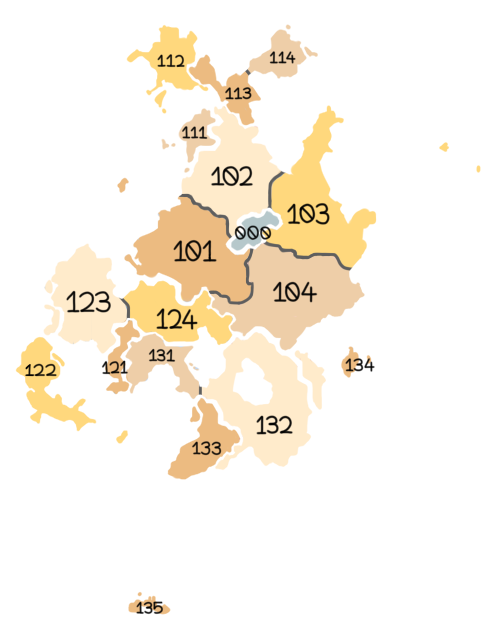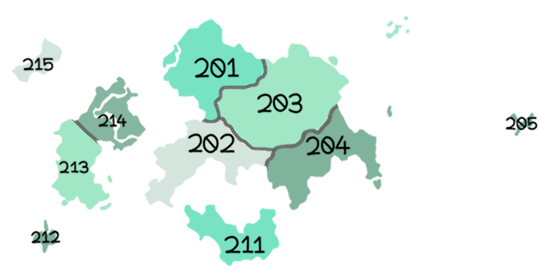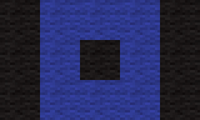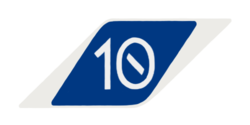Juhwa Islands
| The Juhwa Confederacy 주화연합국 洲化連合国 La confédération juhwa | |
|---|---|
| Motto: 건명원몽 / 建明願夢 "Building the Lights of the Dreams You Desire" | |
| Anthem: Maru Ara (마루 아라) | |
| Capital | Jaeyoon Palace |
| Language | Korean (Official) English (Recognized) Japanese (Recognized) French (Regional) |
| Declared Sovereignty | April 30, 2017 |
| Government | Constitutional monarchy |
| ・ King Foxo | CaptainObi |
| ・ Prime Minister | mi_aquamarine |
| ・ Canton Senators | |
| - Dongryoon | (vacant) |
| - Sanghwa | Starcubed |
| - Gaehwa | (vacant) |
| - Jongnyeong | (vacant) |
| - Jiri | Vulpicula |
| - Yowon | (vacant) |
| Demonym | Supy / Supies |
| Population | 17,197,950 |
| Land Area | 570,290 ㎢ |
| GDP | |
| ・ Total | ₩26.119 trillion JCW ($1.741 trillion USD) |
| ・ Per Capita | ₩1,518,750 JCW ($101,250 USD) |
| Currency | Juhwa Confederacy Won (₩) (JCW) |
| Gini (2020) | 28.2 Low |
| HDI (2020) | 0.929 Very High |
| Name Code | JHI / JI |
| Calling Code | +4 |
The Juhwa Confederacy (Korean: 주화연합국, Japanese: 洲化連合国), or the the Juhwa Islands (Korean: 주화군도, Japanese: 洲化群島) is a country located at the southeastern Epsilon of the MRT. It consists of three major island chains located in the center of Northern Equinox Ocean (known locally as Juhwa Bay), and several smaller island chains. Together, they make up four provinces and one special territory. A small fort governed by the Juhwa Islands also exist at V41 MRT Station named Fort Baekho.
The Juhwa Islands are best known for its fusion of traditional Koreano-Japanese architecture and civillization with artsy, cyberpunk styles. They are also famous for their anthropomorphic (furry) population and culture.
History
The founder of the Juhwa Islands, Supykun, originally founded Janghwa City back in June of 2015. However, due to multiple problems consisting both inside and outside of the MRT, he left and resigned as the Mayor of Janghwa City on June of 2016 and handed his position over to LithiumMirnuriX.
However, Supykun returned to the server around April of 2017 and decided to shift his focus and mission on the server to avoid losing focus on his own builds. He decided to seek a more isolate region of the MRT, and avoid the continent. Hence, the current Juhwa Islands were chosen for settlement.
The Kingdom of Juhwa Islands was officially formed as a governmental sovereignty on April 30, 2017. The first region to develop was Dongryoon East of Sagal Province.
Geography
Administrative Divisions
The Juhwa Confederacy has a system of categorizing its territories:
- Country. The biggest subdivision of them all. Only one country exists, and that is the Juhwa Confederacy. The capital, Jaeyoon Castle, directly controls as the figurehead of this subdivision, and they reserve the ultimate and all final sayings. They also have the right to host national assembly and the supreme commander of the army, the navy, and the military. They have the ultimate say to capital punishment proceedings.
- Province. There are three provinces- Sagal, Inok, and Yongjo. Each of these province have assembly power within their own province, and makes most of the immediate decisions political-wise such as laws. They have the authority to govern minor military such as police and sheriff, and host courts and jails. A leader in this department is considered a governor.
- Canton. There are currently eleven cantons, but one in addition is in evalution. Four are in Sagal, two are in Inok, and five are in Yongjo. They reserve the right to directly govern public infrastructure and make communal decisions, and most local decisions originate from this subdivision. A leader in this department is considered a senator.
- District. Fourty-three districts exists all across the Juhwa Islands. These are regions divided to give ease to organizing local regions and establishing maintenance. If citizens want to issue their voice to the government, this is their platform to use. A leader of this department is considered a mayor.
- Region. This subdivision exists for the purpose of specific location addressing, which would be neccessary for addresses, posts, and police. No leader exists in this category.
Jaeyoon Castle is an exception to all of this, and acts as its own, separate entity.
The etymology of all the region names derived from an aspect each regions hold, such as shape, environment, or culture. As traditionally, the Hanja script is used to ease naming in both Korean and with a little modification, Japanese as well (Kanji). The official names for all the provinces however is usually in Korean as it is the governmental language.
| The Juhwa Confederacy | |||||
|---|---|---|---|---|---|
| Province / Territory | Land Area | Population (2020) | Population Density | Cantons | |
| Sagal | 182,800 ㎢ | 5,202,380 | 28.5 per ㎢ | ||
| Inok | 92,270 ㎢ | 4,170,503 | 45.2 per ㎢ | ||
| Gijo | 183,120 ㎢ | 5,047,598 | 27.6 per ㎢ | ||
| Namhae | 100,980 ㎢ | 2,777,469 | 27.5 per ㎢ | ||
| Haejae Territory | 11,120 ㎢ | -- | -- | ||
Sagal Province
Sagal Province (Korean: 사갈도, Japanese: 砂蠍島) is composed entirely of sands from the deserts and beaches, but has urbanized the most out of the three provinces. There are four cantons (Dongryoon, Sanghwa, Gaehwa, and Jongryeong) along with the Jaeyoon Castle, the nation's capital. During political representation, however, Jaeyoon Castle becomes a neutral territory and excludes itself from Sagal Province's representation.
The provincial color for Sagal Province is designated as orange.
| Canton | District Code |
District | |||
|---|---|---|---|---|---|
| English | Korean | ||||
| Jaeyoon Palace 제윤정성 帝尹政城 |
Jaeyoon Palace | 제윤정성 | 帝尹政城 | Le palais de Jéyoon | |
| Dongryoon 동륜부 胴輪部 |
Dongryoon West | 동륜서구 | 胴輪西区 | Dongryoon de l'Ouest | |
| Dongryoon North | 동륜북구 | 胴輪北区 | Dongryoon du Nord | ||
| Dongryoon East | 동륜동구 | 胴輪東区 | Dongryoon de l'Est | ||
| Dongryoon South | 동륜남구 | 胴輪南区 | Dongryoon du Sud | ||
| Sanghwa 상화부 相和部 |
Hwangnyong | 황룡 | 黄龍 | ||
| Odan | 오단 | 五端 | |||
| Gyeongshin West | 경신서 | 慶身西部 | Gyeongshin de l'Ouest | ||
| Gyeongshin East | 경신동 | 慶身東部 | Gyeongshin de l'Est | ||
| Gaehwa 개화부 開化部 |
Hyeopkae | 협계 | 狭継 | ||
| Biseon | 비선 | 飛鮮 | |||
| Gaehwa West | 개화서부 | 開化西部 | |||
| Gaehwa East | 개화동부 | 開化東部 | |||
| Jongnyeong 종령부 宗伶部 |
Jongnyeong West | 종령서부 | 宗伶西部 | ||
| Jongnyeong East | 종령동부 | 宗伶東部 | |||
| Shiyang | 시양 | 匙樣 | |||
| Chungnang | 청낭 | 青狼 | |||
| Mio | 미오 | 靡鼯 | |||
Inok
🔎 See Inok Province for full description.
Officially known as Inok Islands ( Korean: 이녹도 "Inokdo" ) but also accepted as Rinori Islands ( Japanese: 裏緑島 / りのりじま "Rinorijima" ).
Inok Islands are the smallest out of the three provinces within the Juhwa Islands. With their biome being mostly grassy plains surrounded by beachsands, Inok Island has a balanced climate with adequate precipitation. The Provincial Government of Inokdo (PGI) takes authorization over the Inok Islands. Their flag ring and official color is designated as green.
| Canton | District Code |
District | ||
|---|---|---|---|---|
| Occidental | Korean | Japanese | ||
| Jiri 지리부 芝裏部 |
Jiri North | 지리도 북부 "Jiri-do Bukbu" |
芝裏島 北部 "Shibari-shima Hokubu" | |
| Jiri South | 지리도 남부 "Jiri-do Nambu" |
芝裏島 東部 "Shibari-shima Nanbu" | ||
| Jiri Central | 지리도 중부 "Jiri-do Jungbu" |
芝裏島 中部 "Shibari-shima Chubu" | ||
| Bisung (Côte d'avion) |
비성도 "Bisung-do" |
飛盛島 "Tosaka-jima" | ||
| Wondan (Côte du paradis) |
원단도 "Wondan-do" |
垣根島 "Kakine-shima" | ||
| Yowon 요원부 繞援部 |
||||
Gijo
Gijo Province (Korean: 기조도, Japanese: 起雕島) is the most northern and the biggest out of the four provinces within the Juhwa Islands. Made up completely of swamplands (except for certain extreme small portions and abroad territories), Gijo Islands have heavy precipitation and humidity, and many portions of this province are composed of manmade structures due to some of the territories being under sea-level. Many here prefer to use boats or marine transportations to commute to local areas, and is nicknamed 'The Venetian of the Orient'.
The provincial color for Gijo Province is designated as brown.
Namhae
Being the southernmost province of the Juhwa Islands, Namhae Province (Korean: 남해도, Japanese: 南海道) is readily broken up into several small islands distant from each other. Namhae Province is also significantly separated from the other three provinces, and is politically split by two small islands administered by Cremona, thus somewhat becoming an overseas department.
The provincial color for Namhae Province is designated as blue.
Rivers
Despite the abundance of rivers across Juhwa Islands (most notably Southern Sagal Province and the entirety of Gijo Province), they are a critically important source of life for many Supies as the majority of their food source and staple originate from them. Most of the rivers in the country are used for mixed purposes of farming various crops of rice and vegetables, acquiring clean water, and walkways for citizens (pedestrian) to promote outdoor activities. The river system is divided in the Juhwa Islands as:
・Chesucheon River (채수천 / 菜授川)
↳ Mijeon Sector (미전 / 米畑) - The Ricefield Sector.
↳ Najeon Sector (나전 / 蘿畑) - The Carrot Sector.
↳ Seojeon Sector (서전 / 藷畑) - The Sweet Potato Sector.
Climate
Due to its wide topography stretching horizontally across the Equinox Ocean, Juhwa Islands has diverse climate ranges of which is influenced by the ocean and wind currents surrounding the archipelago. The subtropical jet stream causes Inok and Gijo Province to have cooler climates while Sagal and Namhae Province has warmer climates. Due to the path of the jet stream splitting the entire archipelago, Juhwa Islands as a whole receives consistent, strong southwesterly winds during the summer.
Juhwa Islands can be classified into four main climates: Subtropical, Mediterranean, Temperate, and Oceanic. These apply to the provinces of Namhae, Sagal, Inok, and Gijo respectively. The weather tends to be uniformly cooler to the west and warmer to the east due to lower pressures originating from the northwestern continent and higher pressure on the southeastern continent.
Juhwa Islands is surrounded by cooler waters on the western coasts and warmer waters on the eastern coasts. As Equinox Ocean is located on the Southern Hemisphere of the MRT World, the ocean currents circulate anti-clockwise around Juhwa Islands, resulting in the eastern warmer waters to flow north (Myowan Current) and the western cooler waters to flow south, then west (Duseung Current). Myowan Current transfers all its waters westward at the northern end of the Equinox Ocean and transitions to Duseung Current through the narrow Duseung Strait and results in an unusually strong ocean current. All other connecting waterways between the two currents such as the Juhwa Strait, Sagal Bay, and Namhae Sea acts as minor eastward currents for Duseung Current waters to transition back to Myowan Current.
The warmer waters east of Juhwa Islands however form strong typhoons during summer which generally travels northeast. This sets a majority of the Juhwa Islands vulnerable to typhoon damages along with Kanto, Arbatskaya Moscow, Cremona, Murrville, and Richville in descending order of severity. If there are higher pressures east of the subtropical jet stream, typhoons curve more westward towards the Juhwa Islands whereas lower pressures would mean the typhoon would curve eastward towards the other cities and states. Uniquely, Richville receives less, but stronger typhoons as the typhoon must travel a path made by western high pressure and eastern low pressure which would surpass Gijo Province and strike Richville.
Service Systems
Postal Code / Address
The national postal agency of Juhwa Islands is the NPN (Nexus Postal Network). Supies usually refer to post offices as the NPN.
Unlike most of the MRT World, Juhwa Islands does not use the Vermilion Postcode System (VPS), and uses the NPN Standard instead. NPN Standard was created against VPS as Juhwa does not have a road/street-centric civillization. Furthermore with Juhwa's roads and streets greatly based underground, an address system with compatibility for multi-layered geography was needed.
There are two different accepted variants of the NPN Address: Standard and Universal.
- Standard addresses are generally used among normal circumstances. It is a general etiquette to use the standard address when sending something which a person will read (i.e. handmade letters or packages), or formal circumstances (i.e. business letters).
- Universal addresses are made for two purposes- to ease understanding among Supies who do not speak the same language, and to allow faster task completions. This type of address is used especially in delivery or corporations where speed is critical factor.
The current NPN Address format was revised as the third edition on October 15th, 2019. The second edition revision on May 21st, 2019 was short-lived.
| Address (Korean) | Address (English) | Address (Japanese) | |
|---|---|---|---|
| Standard | 주화연합국 GR [사] 동륜부 동륜서군 포위동 10-101-사 포위종합도서관 수피꾼 귀하 |
Juhwa Islands GR [S] Dongryoon-bu Dongryoon West, Powi-dong 10-101-PO Powi Library Complex To Supykun |
洲化連合国 GR [砂] 輪東部 胴輪西郡 抱慰洞 10-101-私 抱慰総合図書館 スピクンさん |
| Universialized | 주화 GR103 포위 10-101-사 수피꾼 귀하 |
JI GR103 Powi 10-101-PO To Supykun |
洲化 GR103 抱慰 10-101-私 スピクンさん |
| ★ The NPN Address System Guide ★ | |||||||||||||||
|---|---|---|---|---|---|---|---|---|---|---|---|---|---|---|---|
| Juhwa Islands GR [S] Dongryoon-bu Dongryoon West, Powi-dong 10-101-PO Powi Library Complex To Supykun (Standard Example Address) | |||||||||||||||
| Standard Example Address | Indication | ||||||||||||||
| Juhwa Islands | Country | ||||||||||||||
| GR | [S] | Dongryoon-bu | Dongryoon West | Powi-dong | Altitude | Province | Canton | District | Region | ||||||
| 10 | 101 | PO | Powi Library Complex | Building # | Unit # | Postbox Note | Name of Place | ||||||||
| To Supykun | Recipient | ||||||||||||||
| JI GR103 Powi 10-101-PO Powi Library Complex To Supykun (Universal Example Address) | |||||||||||||||
| Universal Example Address | Indication | ||||||||||||||
| JI | Country | ||||||||||||||
| GR | 1 | 0 | 3 | Powi | Altitude | Province | Canton | District | Name of Place | ||||||
| 10 | 101 | PO | Powi Library Complex | Building # | Unit # | Postbox Note | Name of Place | ||||||||
| To Supykun | Recipient | ||||||||||||||
| On Standard | On Universal | Description | |
|---|---|---|---|
| Country / City | Juhwa Islands | Juhwa Islands | Refers to the name of the state you are sending the post to- it can be a city, city-state, town, etc. But since NPN Address is as of now used solely for the Juhwa Islands, it is almost certain that this space will be marked as 'Juhwa Islands'. However, if this is not an international-based delivery, this section does not require to be written. |
| Province (Province Code) |
Sagal-do | 1 | There are officially three provinces in the Juhwa Islands. Each of the provinces are also given a number for representation, in which universal addresses use:
In addition, islands or territories that are not designated underneath any provinces are marked (0). For standard addresses, it would be written as 'Special Territories' |
| County (Region Code) |
Dongryoon East | 104 | Indicates which county you are intending to send your post to. For standard addresses, you just write in the county name. If you are writing in universal form, this section must be a number based on the administrative division map shown above. If you intend to send to a Special Territory, depending on which one it is, there may or may not be a region code. |
| Altitude | yGR | yGR | This section indicates the elevation level of where A) the location of the intended P.O. Box is, or B) the location of the front door to place the post in front of. This feature enables differentiation between plural buildings or departments where the location may be identical but on different ground levels. - To write your altitude, check your y-altitude and write the number of it next to a lowercase 'y' (i.e. y36). |
| Building Number | 01 | 01 | The number assigned to the building by the government. |
| Unit Number | 101 | 101 | If your location is specifically a room or a unit inside a building, this should be where you place your number. |
| Postbox Note | PO | PO | Usually, this is a spot which you can identify if your post will be going in a P.O. Box or not. If it is, 'PO' is written at this section. But additionally, other codes can come in and replace, or add on:
|
| Name of Destination | Court of South | Court of South | The name of the location you wish to send your post to. This is a manual procedure to figure out. |
| Recipient | To Supykun | To Supykun | The person you are intending to send your post. |
Phone System
The International Dialing Code of the Juhwa Islands is +4 in accordance with the MRT Ward System and the Creeperville Telecommunications System (CTS).
Formerly up until May 31st, 2019, +9 was used to match with Ninechannel, the national broadcasting corporation of the country. This meant Juhwa Islands used to be the only state on the MRT World to defy the MRT Ward System. Presumably due to shift of concerns, the Royal Government issued a bill to change the phone code to comply within the local ward (Ward 4), and the National Assembly footed the bill into immediate effect.
The regional code which follows after changes depending on the canton and the district.
Demographics
The official demonym to refer to the people from The Juhwa Islands is called a Supy, or Supies in plural form. In addition, The Juhwa Islands are the only state in the MRT which is majorly compromised of anthropomorphic citizens. Despite there being a few fursuiters here and there, Supies are natural furries themselves (humans with physical animal characteristics), and therefore has a majorly diverse and different anatomical differences from the rest of the people in the MRT World.
Species (Ethnicity)
The total population of the Juhwa Islands as of 2020 is 17,197,950. Out of those, 16,379,000 (95.2%) are animal form-based Supies and 818,950 (4.8%) are humans of Juhwanese descent. Foreigners are not counted in the population chart.
Because Supies are not genuinely related to their comparable animal counterparts genetically, when referring to their species a special grammar is used to distinguish between the two. When referring to Supy's species the ending would be added or replaced with an "-o" or "-ie" (ex. wolf → wolfo). In rarer cases, this rule will not be used and just placing "-supy" after the word will be effective (ex. kitty → kittysupy). Disregarding this grammatical rule can cause referential confusion.
Language
🔎 See Languages of Juhwa Islands for full description.
Korean is the official government language used in the Juhwa Islands. In order to be inaugurated into a governmental position or in general do business in Juhwa Islands, Korean is a principal language. However, Korean spoken in the Juhwa Islands tends to differ slightly to the original spoken in South Korea, and is considered a separate dialect. English is also commonly spoken in the country, and also tends to carry a dialectal twist.
Other languages used noticeably includes Japanese, French, and to lesser extent Spanish. Japanese Supies are spread evenly throughout the country, but French Supies are mostly clustered around Les Côtes regions in Eastern Inok Province.
| Language | ||||
|---|---|---|---|---|
| Korean | ||||
| English | ||||
| Japanese | ||||
| French | ||||
| Spanish | ||||
| Other |
Economy
Juhwa's economy is directly represented as the king's possessions with a total GDP amount of around $13,300 per person. This is a very high standard in the MRT World, and as of May 2019, is ranked the 16th richest state in the world. The highest Juhwa Islands ever ranked in GDP was 5th place with around $12,000 in 2016.
Juhwa Islands are a major exporter of agricultural products, brands and franchises, supytarian (humanitarian) aid, arts, and elite education. Due to strict regulations by the government, imports are minimal and usually consists of brands, franchises, and machineries.
The following is the list of businesses headquartered and operating natively in the Juhwa Islands.
Social Services
Medical (Hospital)
🔎 See Safety of Juhwa Islands for full description.
There are a total of eight designated major hospital infrastructures across the Juhwa Islands, each capable of handling sudden, major incidents; three are in Sagal-do, two are in Inok-do, and three are in Gijo-do. All eight are governed by law under the E.S.K. (Korean: 의술국 / Japanese: 医術局), the medical agency of Juhwa Islands.
Transportation
Road
Freeways (Highways)
🔎 See Freeways of Juhwa Islands for full description.
Each freeway is designated as Routes (i.e. Route 10 as shield shown on the right), and most are located underground as tunnels due to shortage of available space aboveground. The average freeway in Juhwa has four lanes, and carpool lanes and toll roads (with the exception of inter-provincial roads) do not exist. The freeways in the Juhwa Islands do not extend into foreign territories and therefore operates independently from general highway regulations implemented by the MRT.
The freeway system of Juhwa Islands are categorized by its numeral size and regions.
Rail
Due to the fact that the location of Juhwa Islands is rather isolated at the far outskirts of the MRT World with no noticeable settlement anywhere near, they are physically unable as of now to participate in major long-distance rail connection services. Furthermore, due to the fact as a densely structured island, the idea of a long distance rail service has long deemed to be unnecessary, and instead a more localized version of rail service was put into focus and developed.
・ Metro
🔎 See JHR for full description.
The JuhwaMetro ( Korean: 주화전철 'Juhwa Jeoncheol' / Japanese: 洲化電鉄 'Shuka Dentetsu' ), or just referred to as the JHR, is a metro/subway network connecting the entirety of the Juhwa Islands territory thoroughly (with the exception of special territories). It consists of nine major lines (each numbered from 1 to 9), and accounts for around a projected number of 90 stations. Once completed, it will be known as one of the largest local metro system in the MRT World.
・ Train
As of now, there is only a plan to make a high speed train system between West Juhwa Station, and East Juhwa Station, with JuhwaRail being in charge of the project. Plans to connect to the continent may come into plan once a noticeable settlement or agreement becomes visible, but until then, will be unlikely.
Culture
Sports
The two most popular sports in the Juhwa Islands are baseball and international football (soccer). Both sports has leagues with many different teams throughout all four provinces and a major fan culture is present around these teams.
For baseball, the national governing body is the Domin Yagu Championship (DYC). There are sixteen teams within DYC- five in Dongryoon, three in Inok, six in Gijo, and two in Namhae. They are also split into two conferences: Glaceus League for clubs closer to the western coasts and Igneus League for clubs closer to the eastern coasts.
Stadiums and Arenas
As of currently, rhere are various arenas and stadiums under construction:
- The Cyclone Bloom (사이클론 블룸) is a multicomplex mall-and-stadium located at Dongryoon Northeast County of Sagal Province. It is scheduled to be the tallest, and also the only hexagonal stadium and spleef floor available in the MRT World. The shape of the stadium is similar to a geometrically refined cyclone (tornado) bowl which inspired the name. Fencing and Sparring is also played on this stadium.
- Chungnang Oval (청낭 아이스경기장) is a subaquatic arena located east of Chungnang Island of Sagal Province. Located underwater, Chungnang Oval is laminated with pressure-resistant glass that can hold up to ten thousand tonnes. Primarily hosts ice speed skating events.
Government
Political System
🔎 See Laws and Decrees of Juhwa Islands for full description.
Military
Official song of the JuhwaHaegun (JuhwaNavy).
The Juhwa Islands possesses a major navy presence across the eastern half of Equinox Ocean, and plays the role of safekeeping borders and catching pirates and illegal fishers. As a country of archipelago, Juhwa Islands invest the most in their navy power, followed by Air Force (JuhwaGongun) and then Army (JuhwaYukgun).
Flag
The official flag of the Juhwa Islands is the Sekjin Gi (색진기 / 色進旗). It was formerly the flag of Janghwa Metropolitan City from June of 2015 to February of 2017 until a regime change occured. The Sekjin Gi consists of a slightly-darkened white background with three diagonal stripes of light gray, gray, and black on the left of the flag.
The name Sekjin Gi translates to "The Flag of Transitional Hues". It refers to the dark-to-bright transitional scheme from the darker bars into the bright background. The black triangle represents of the dark and abusive history of the kingdom, and the transition to larger shapes indicates a promise to a wide, bright future. The gray symbolizes bold confidence, the light gray symbolizes order and progress, and the white symbolizes today as the vast space of open ideas and potential to be a creative Mecca of the MRT World. The bars going diagonal instead of vertical or horizontal symbolizes the culture of Juhwa being unique, seeking to break norms and innovate.
The Sekjin Gi used to have a black star (★) on the top left corner while the three gradient bars were half the size at the lower left corner. The black star was a symbol of dynamism, zenith, 'apex of the world', and the refusal to admit defeat to the end. This variation of Sekjin Gi was used during the darker history of the Juhwa Confederacy, but the star was removed as the gradient took over the left of the flag when Juhwa turned its focus on becoming a free nation, deeming it to be too militaristic and egocentric. Conservative Supies however, use the flag to promote nationalism.
Anthem
Maru Ara (Korean: 마루 아라, Japanese: マル・アラ) is the national anthem of the Juhwa Confederacy.
Created in May 31st, 2016, Maru Ara is one of the oldest anthems to be adopted on the MRT World, and is among one of the few originally composed anthems on the MRT World. The melody of Maru Ara was originally made as a military march for Janghwa City, and shortly after became their national anthem until their downfall and the disestablishment of their military. The song became obsolete until the resurrection in the form of Juhwa Islands, and Maru Ara was re-established as an anthem on April 30th, 2017.
As the song was originally a military march tune, Maru Ara exhibits strong militaristic vibe for an anthem, but the Government decided to retain Maru Ara as a commemoration of the darker past Juhwa Islands had to endure. A total of three revisions took place since its first composition to shorten the six-minute anthem to three (Once in February 9th, 2018, and once in May 10th, 2020). When required an even shorter version of the anthem (i.e. during international football events or medal ceremonies) the anthem can be played from the cannon part (2:09 in the audio).
The lyrics went through many changes as the original lyrics were deemed unsuitable and graphic. The current lyrics were revised on May 10th, 2020 to adjust with the shortened anthem. Most Supies prefer not to sing the lyrics however as previous lyrics instilled negative connotations on Maru Ara's lyrical composure, and most either just listen in silence or sing the melody only.
The name, "Maru Ara" is a combination of two ancient Korean words "Maru" (마루) and "Ara" (아라) which means sky and sea respectively. This title was created by pulling the two keywords throughout the main stanza. Previously, Maru Ara took in many different titles such as "The Rise of the Falcon", "March of the JanghwaGunsa", and "March of the Grand Earth". None of them fared well.
| Lyrics (Korean) | |||
|---|---|---|---|
| Romanized | Translation | ||
|
가온누리 (x2) 온누리의 (x2) -- (x2) (x2) |
gaon nuri (x2) onnuri e (x2) -- (x2) (x2) |
May you rise (x2) The glowing streams (x2) -- (x2) (x2) | |
Diplomacy
As Juhwanian Law limits official diplomacy by exchanging embassies, the Juhwa Confederacy maintains official diplomatic relations with few states.
| Name of State | Association State | Head of State | Established | Note | |
|---|---|---|---|---|---|
| For Recipient | From Recipient | ||||
| AlikSong | |||||
| _frozen | Original mayor has been absent for several years. | ||||
| ||||
| New Amsterdam, Hensall | Richville, Riseau | – | ||
| Pearl Coast | Kanto | |||
| ||||
| – | Cremona, Murrville | – |











